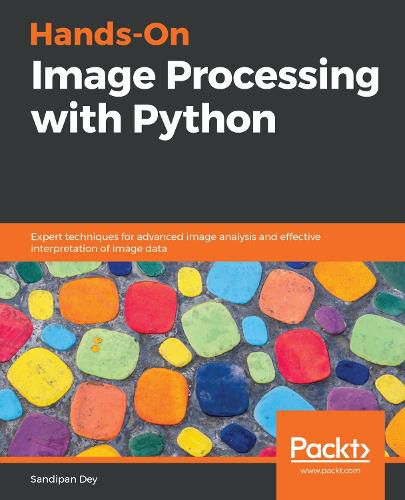Readings Newsletter
Become a Readings Member to make your shopping experience even easier.
Sign in or sign up for free!
You’re not far away from qualifying for FREE standard shipping within Australia
You’ve qualified for FREE standard shipping within Australia
The cart is loading…






This title is printed to order. This book may have been self-published. If so, we cannot guarantee the quality of the content. In the main most books will have gone through the editing process however some may not. We therefore suggest that you be aware of this before ordering this book. If in doubt check either the author or publisher’s details as we are unable to accept any returns unless they are faulty. Please contact us if you have any questions.
Explore the mathematical computations and algorithms for image processing using popular Python tools and frameworks.
Key Features
Practical coverage of every image processing task with popular Python libraries Includes topics such as pseudo-coloring, noise smoothing, computing image descriptors Covers popular machine learning and deep learning techniques for complex image processing tasks
Book DescriptionImage processing plays an important role in our daily lives with various applications such as in social media (face detection), medical imaging (X-ray, CT-scan), security (fingerprint recognition) to robotics & space. This book will touch the core of image processing, from concepts to code using Python.
The book will start from the classical image processing techniques and explore the evolution of image processing algorithms up to the recent advances in image processing or computer vision with deep learning. We will learn how to use image processing libraries such as PIL, scikit-mage, and scipy ndimage in Python. This book will enable us to write code snippets in Python 3 and quickly implement complex image processing algorithms such as image enhancement, filtering, segmentation, object detection, and classification. We will be able to use machine learning models using the scikit-learn library and later explore deep CNN, such as VGG-19 with Keras, and we will also use an end-to-end deep learning model called YOLO for object detection. We will also cover a few advanced problems, such as image inpainting, gradient blending, variational denoising, seam carving, quilting, and morphing.
By the end of this book, we will have learned to implement various algorithms for efficient image processing.
What you will learn
Perform basic data pre-processing tasks such as image denoising and spatial filtering in Python Implement Fast Fourier Transform (FFT) and Frequency domain filters (e.g., Weiner) in Python Do morphological image processing and segment images with different algorithms Learn techniques to extract features from images and match images Write Python code to implement supervised / unsupervised machine learning algorithms for image processing Use deep learning models for image classification, segmentation, object detection and style transfer
Who this book is forThis book is for Computer Vision Engineers, and machine learning developers who are good with Python programming and want to explore details and complexities of image processing. No prior knowledge of the image processing techniques is expected.
$9.00 standard shipping within Australia
FREE standard shipping within Australia for orders over $100.00
Express & International shipping calculated at checkout
This title is printed to order. This book may have been self-published. If so, we cannot guarantee the quality of the content. In the main most books will have gone through the editing process however some may not. We therefore suggest that you be aware of this before ordering this book. If in doubt check either the author or publisher’s details as we are unable to accept any returns unless they are faulty. Please contact us if you have any questions.
Explore the mathematical computations and algorithms for image processing using popular Python tools and frameworks.
Key Features
Practical coverage of every image processing task with popular Python libraries Includes topics such as pseudo-coloring, noise smoothing, computing image descriptors Covers popular machine learning and deep learning techniques for complex image processing tasks
Book DescriptionImage processing plays an important role in our daily lives with various applications such as in social media (face detection), medical imaging (X-ray, CT-scan), security (fingerprint recognition) to robotics & space. This book will touch the core of image processing, from concepts to code using Python.
The book will start from the classical image processing techniques and explore the evolution of image processing algorithms up to the recent advances in image processing or computer vision with deep learning. We will learn how to use image processing libraries such as PIL, scikit-mage, and scipy ndimage in Python. This book will enable us to write code snippets in Python 3 and quickly implement complex image processing algorithms such as image enhancement, filtering, segmentation, object detection, and classification. We will be able to use machine learning models using the scikit-learn library and later explore deep CNN, such as VGG-19 with Keras, and we will also use an end-to-end deep learning model called YOLO for object detection. We will also cover a few advanced problems, such as image inpainting, gradient blending, variational denoising, seam carving, quilting, and morphing.
By the end of this book, we will have learned to implement various algorithms for efficient image processing.
What you will learn
Perform basic data pre-processing tasks such as image denoising and spatial filtering in Python Implement Fast Fourier Transform (FFT) and Frequency domain filters (e.g., Weiner) in Python Do morphological image processing and segment images with different algorithms Learn techniques to extract features from images and match images Write Python code to implement supervised / unsupervised machine learning algorithms for image processing Use deep learning models for image classification, segmentation, object detection and style transfer
Who this book is forThis book is for Computer Vision Engineers, and machine learning developers who are good with Python programming and want to explore details and complexities of image processing. No prior knowledge of the image processing techniques is expected.